
Keke Kaikhosroshvili
Keke is Zavvy's expert in learning experience. On our blog, she shares experience and insights based on her studies in learning design and experiences made with our customers.

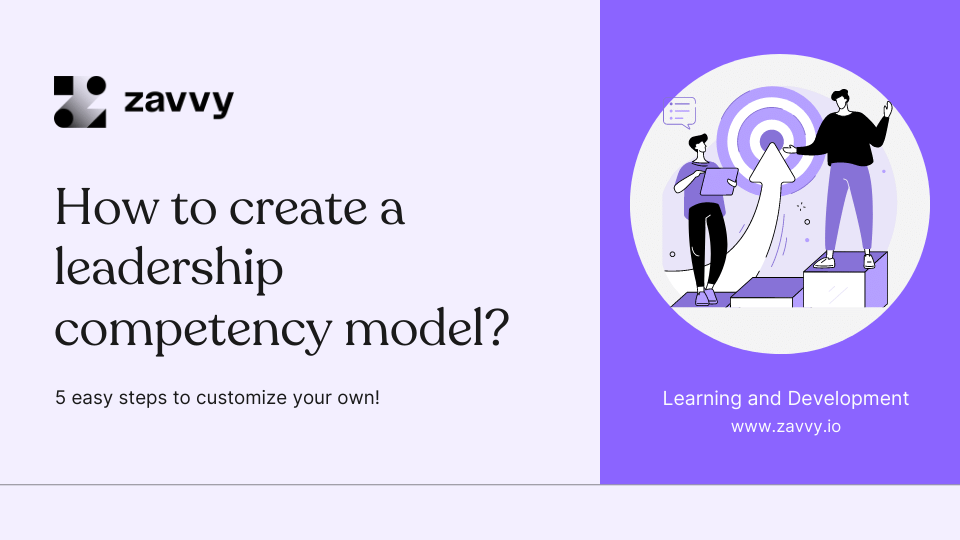
It is no secret that leadership plays a vital role in an organization's success.
Businesses need leaders to hold the teams together, guide them through change and achieve organizational objectives.
Employees' expectations from their employers have increased since the start of the coronavirus pandemic. People want to work at companies that value employee engagement, promote Learning & Development (L&D), and encourage employee well-being.
When a crisis like the Great Resignation has made record numbers of Americans leave their job last year, companies need strong leadership to retain talent.
Gartner says only 27% of business units have the leaders they need for the future.
A great leader can sail a ship to the shore even during a bad storm. But hiring a solid leader isn't a cakewalk. As per Gallup, most organizations struggle to find good managers. Therefore, companies need standardized systems to streamline hiring, assessment, and promotion.
A leadership competency model is one such tool that can help HR hire and identify exemplary leadership talent to steer the company forward.
Together with our curators, we have created a library of actionable digital marketing resources. Personalized to your team's needs.
Before we talk about the competency model, let's first understand competencies.
Competencies are a person's general abilities and talents that allow them to complete the responsibilities of a specific job successfully. They may also include personal characteristics required for success in a particular line of work, sector, or company.
The competencies required for success differ across the industry, role, or organization.
Competency = Knowledge + Skills + Abilities
A competency model is a tool used by HR professionals or senior management to determine and measure the competencies an employee needs to perform his job effectively.
A competency framework or competency model can help organizations assess performance, reward top performers, and retain talent by identifying competencies in employees who have shown exceptional performance. The competencies determined in the model form the basis of hiring decisions across industries and companies and set a standard for outstanding performance.
The model directs workers on how they need to perform effectively. Competency models also help in competency mapping to identify competency gaps and plan training and upskilling for employees.
You can check this detailed guide to learn more about competency models.
Leadership is the ability to inspire and guide others towards a common goal. People choose to follow leaders working towards solving a problem that aligns with their interests and beliefs.
"Leadership is not a magnetic personality. It is not making friends and influencing people. Leadership is lifting a person's vision to high sights and raising performance to a higher standard."
– Peter Drucker
People or organizations' definition of leadership is contextual, and you can find good leaders in all walks of life.
A college senior or a manager that had a profound positive impact on your life might be a good leader in your eyes. Elon Musk or Mark Zuckerberg exemplifies leadership for an aspiring entrepreneur. Michael Jordan or Cristiano Ronaldo may be the epitome of strong leadership for a sports fanatic.
A leader sets the vision for his team and inspires them to give their best. It is important to note that leadership can't be forced upon people or inherited; it has to be learned and practiced by those who want to lead.
Elon Musk symbolizes strong leadership in the below excerpt.
"We want our leaders to find ways of motivating and inspiring their teams, reduce the noise in their work and help remove blockers. If you are a manager or leading at any level at SpaceX, we stress that your team is not there to serve you. You are there to serve your team and help them do the best possible job for the company.
This applies to me most of all. Leaders are also expected to work harder than those who report to them and always make sure that their needs are taken care of before yours, thus leading by example."
Leadership is crucial because it helps organizations predict and manage change more effectively and tackle complex problems better than their competitors. In addition, it helps businesses win the trust of their employees and stakeholders.
Good leadership helps employees understand the goals, identify their role in achieving them, and effectively execute tasks.
A leadership competency model is a framework used by HR professionals or senior executives to determine and evaluate leaders' competencies for outstanding performance. It helps assess leadership potential, identify training needs, and implement relevant development programs.
Leadership competencies include behaviors and skills directly attributable to leadership effectiveness and performance.
In short, it's a competency model (as defined earlier) to assess and develop leadership competencies among employees and existing leaders within an organization.
The leadership competency model also helps businesses assess leadership talent by identifying exceptional employees. It also tells the workforce what competencies the organization will evaluate for leadership roles and gives aspiring managers direction to improve.
For example, leadership competency models may include emotional intelligence, decisiveness, and strategic thinking. These competencies are not necessary for individual contributors but essential for managerial roles.
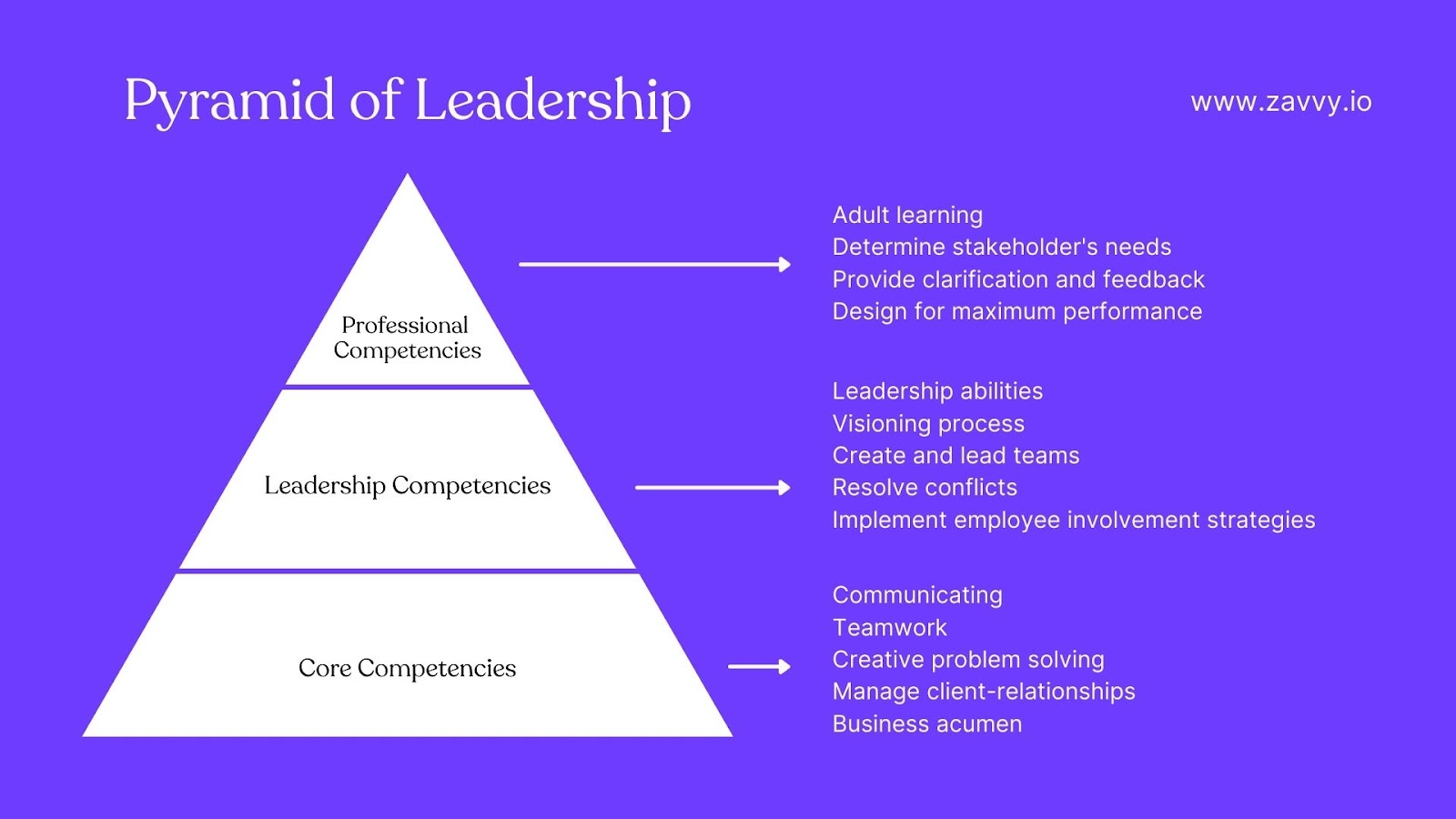
What makes a great leader?
What specific skills and qualities set them apart from everyone else?
To answer these questions, you have first to understand the concept of core leadership competencies.
Every organization is different, so the competencies that define a good leader in one company might not be relevant in another.
For example, the critical leadership competencies needed to manage a not-for-profit organization will differ from those required to run a software company. But some competencies are essential for any leader, regardless of the company or industry.
As per a Boston Consulting Group survey done in 2020, ideal leaders should be human-centric and display five main qualities:
A core leadership competency combines the required knowledge, skills, and abilities an employee in a leadership role should have to help an organization effectively work towards its mission. These are leadership traits that all leaders need to be effective. It can range from interpersonal skills, such as empathy and influence, to more technical leadership skills, such as planning and decision-making.
"A leader must see the external opportunities and the internal capability and culture, and all of the connections among them and respond to them before they become obvious parts of the conventional wisdom."
- Satya Nadella
You can learn leadership competencies during on-the-job leadership development opportunities or leadership development programs.
Let's take the example of UNESCO's Competency Framework to learn more about them.
One of the three components of UNESCO's competency model is "Managerial competencies." Staff with management responsibilities at the P-4 level (employees having minimum work experience of seven years) and above are covered by this standard.
UNESCO defines six core leadership competencies as listed below:
Note: The explanation of competencies has been paraphrased for better comprehension.
A leadership competency model helps HR and L&D managers identify and develop leaders within their organization.
A leadership competency model enables the Talent team to identify the skills and attributes essential for successful leadership. By having a defined framework to guide leadership selection and development, HR executives can select qualified candidates and help them to grow into influential leaders.
A leadership competency framework also helps you develop training programs and define standards that will help leaders improve their skills.
Here are the benefits of using a leadership competency model:
Let's talk in detail about each benefit.
An organization's typical problem when managing leadership is identifying and assessing leadership performance.
Good leadership depends upon many factors such as innate abilities, motivations, life experiences, and leadership competencies. All these can be difficult to measure across a leadership team, but having a leadership competency model in place makes it more convenient. It provides an objective structure with clear developmental milestones for leadership development.
A leadership competency model helps an organization define the behaviors and skills necessary for its leaders to perform as per the desired performance standards. The senior management and HR can then use this information to set clear expectations from its leaders.
A leadership competency framework also creates a performance management process tied to an employee's knowledge, skills, and abilities.
Suppose an organization uses a competency model that has "Provides excellent customer service" as an assessment parameter. In that case, it might use feedback surveys and other tools to collect data about how well each leader is meeting this goal.
Having a leadership competency model can help the HR teams gauge leadership effectiveness across the organization. When companies document ideal performance for each role, it's easier to identify training gaps.
Knowledge of training gaps helps HR and L&D professionals prioritize training programs for existing leaders. Leadership competency models also help incumbents identify their areas of strength and weakness and the skills they need to develop to lead their teams effectively.
"Leadership and learning are indispensable to each other."
- John F. Kennedy.
Employees with managerial responsibilities can take customized leadership development courses that will help them improve their leadership skills and meet required performance standards.
Succession planning for senior-level leadership is often unsuccessful because of a lack of clearly defined job descriptions. Lack of information makes it challenging to determine what competencies potential successors need.
The leadership competency model helps by providing a clear picture of the leadership skills and experience required to effectively perform at different leadership levels. In addition, it helps with leadership succession planning by identifying those employees who have the right combination of leadership skills and knowledge to lead teams in the future.
Most leadership competency models include corporate values and other information that helps organizations identify the leadership traits that are most important to their success.
HR professionals can use this information to identify leadership candidates who have the right leadership skills and transferable experience for a leadership role.
For example, WHO Global Competency Model includes "Promoting Innovation And Organizational Learning" as one of the leadership competencies. Because the recruiters at WHO have a framework to evaluate potential hires for leadership roles, they can filter candidates who have a history of promoting innovation and learning in their previous positions.
A leadership competency model improves employees' understanding of what's needed to be strong leaders in their current roles and the potential leadership roles they might play in the future.
Employees put in extra effort for leadership roles if they have objective measures of leadership effectiveness. It helps HR leadership teams create a leadership model that includes factual leadership behaviors while still allowing employees to demonstrate their leadership strengths.
As an HR executive, you can develop a leadership competency framework to provide the workforce with a detailed explanation of the leadership competencies.
Creating a model standardizes effective leadership — so that you can identify gaps in your organization and stop the leaks in your team's leadership pipeline. You can then link this information to complete an individual development plan (IDP).
Developing a competency framework will also demonstrate your competence as an HR or L&D professional.
The first step in creating a model is to define your company's requirements and goals.
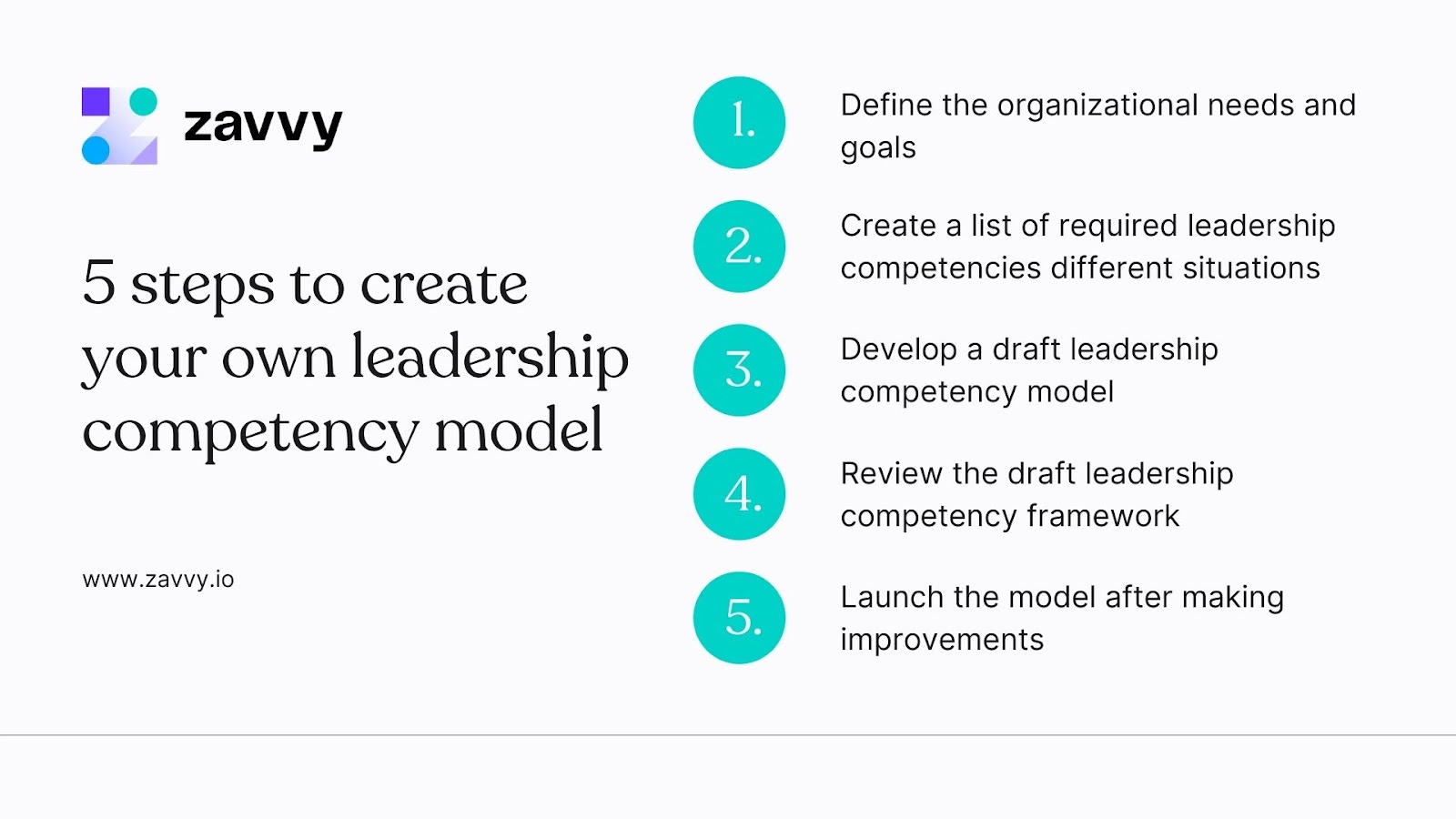
Ask yourself:
If your company already has an existing model, then scrutinize it and ensure the new model fills any gaps.
Conduct assessments to measure the skills and abilities of your employees and identify performance gaps.
You can massively increase the efficacy of your leadership competency framework by taking inputs from past and existing successful leaders associated with your firm.
Gather expert insights using:
Analyzing the existing model and gathering expert insights will give you a strong understanding of what leadership competencies are missing from your company. It will empower you to clearly define the need and goals behind creating a leadership competency model.
After you analyze the existing model and gather expert insights, describe the ideal leadership behavior in your organization.
Create a list of core leadership competencies based on the outstanding leadership conduct necessary for your company to excel and group similar competencies. Each should be relevant to its role and closely connected to leadership behaviors.
The range of competencies will depend on your organizational needs and culture.
For example, The U.S. Office of Personnel Management (OPM) defines 22 leadership competencies necessary for building federal corporate culture. They are divided into five categories (called executive core qualifications or ECQs), as given below.
In addition to these five categories, OPM also defines six Fundamental Competencies that act as a foundation for each type mentioned above. These fundamental competencies are Interpersonal Skills, Integrity/Honesty, Oral Communication, Written Communication, Continual Learning, and Public Service Motivation.
The required leadership competencies may vary based on company goals.
For example, WHO Global Competency Model (referenced earlier) has added: "Promoting WHO's Position In Health Leadership" as a leadership competency. On the other hand, the knowledge and skills a senior leader at a pharmaceutical company needs will differ because, unlike WHO, his company's mission is to make profits.
After analyzing the organizational goals, research, and expert insights gathered in the previous steps, create a draft leadership competency framework.
Developing a draft before revealing the leadership competency model to employees gives you leeway to make changes.
Explain each leadership competency in detail and include illustrations of effective and ineffective leadership behavior.
Categorize the proficiency level of each competency on a scale depending on the level of impact they have on the organization's effectiveness.
For example, OPM describes the proficiency level for leadership competencies as follows:
You can create your scale to define different proficiency levels.
Once you create a final draft of the leadership competency framework, start evaluating its effectiveness in a small group.
Remind all the stakeholders of the primary goals behind creating or updating the leadership competency model.
For example, suppose you're an HR at a Financial Tech startup where technology implementation is of paramount importance. In that case, your goal should be to hire a Chief Technology Officer (CTO) with solid experience in implementing complex technology solutions.
Get the competency framework reviewed by leadership experts, past and present C-Level executives, existing managers to test its effectiveness. You can also do performance evaluations that assess the change in leadership abilities of the sample group.
While making data-backed decisions is vital, you should consider a leadership candidate's personality if it aligns with your company's vision.
Bonus tip: If your organization has teams worldwide, include the model's target audience (people in leadership roles or aspiring managers) from different demographics and genders. Testing the model on a diverse audience can tell HR its long-term effectiveness.
As an HR manager, identify and measure changes in leadership behavior by conducting interviews and performance evaluations based on the draft competency model.
Improve the framework after collating the data on the efficacy of the draft competency model.
Aforementioned, a competency framework is used to identify performance gaps and suggest customized training. Feel free to add leadership competencies if you recognize any additional gaps during assessments based on the draft model.
Ensure that every stakeholder has the same understanding of each competency, proficiency level, and expected behavior. Use simple language that coherently explains each point.
Once you've made the improvements, launch the competency model across your organization for assessing leadership competencies. Using an online platform or a software application for developing leadership competencies will make it easier to share knowledge across the organization.
"As a leader, it is important to not just see your own success. But focus on the success of others. There are so many people who work so hard and try new things every day. As a leader, we should guide them to succeed. Focusing on the team is one of the most important jobs for a leader."
- Sundar Pichai
While we try to learn from other successful leaders' journeys and working styles, taking inspiration from other leadership competency models will help you create your own.
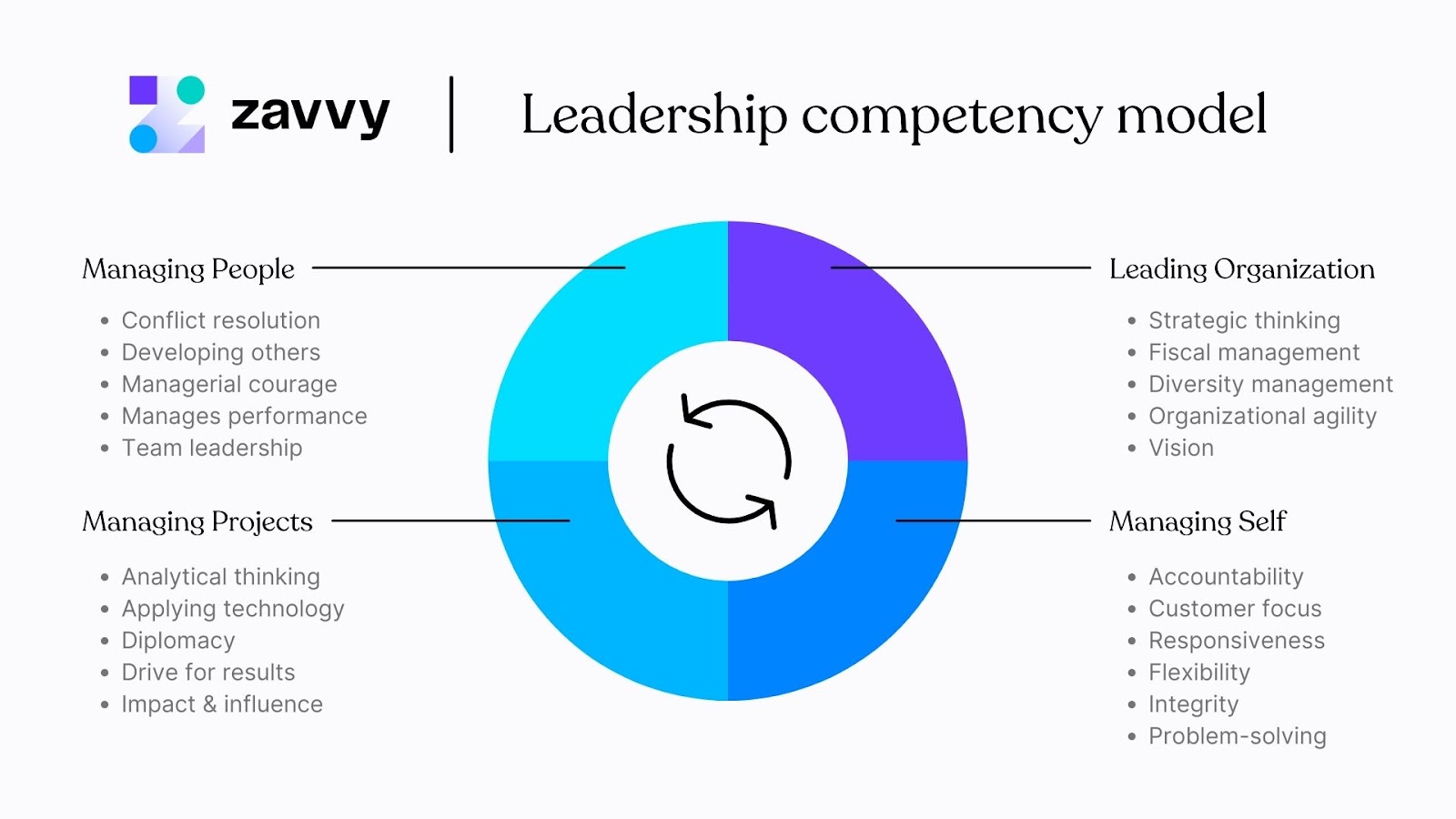
You can follow all the steps stated above to create your own model and take inspiration from the following ten examples of leadership competency models.
Leadership competency models are a great way to identify and develop leaders within your organization. By having a clear understanding of the core leadership competencies, you can better assess and cultivate the skills of your current and future leaders.
There are many benefits of using a leadership competency model, including fruitful leadership performance assessment, creating L&D plans to fill competency gaps, and improved leadership hiring. Additionally, when employees understand the expectations for leadership behavior, they are more likely to live up to those standards.
We’ll be happy to consult you on the best leadership competency models for your industry and organization.
It's time to stop relying on assumptions about leadership. It is a skill that can be learned and improved upon by understanding the core competencies that make up a strong leader.
Zavvy's Micro lessons Template goes beyond the traditional 'handed down knowledge'. Taking inspiration from successful thought leaders and their unconventional practices, this template offers binge-worthy content on leadership practices, techniques, and reflections.
Leaders are at the top of an organization's hierarchy. And helping their learning and development process is among our main priorities. With Zavvy you can solve people development with a click. Connect with our experts to learn how!
Upskill your team every week with the best contents and personalized recommendations.

It is no secret that leadership plays a vital role in an organization's success.
Businesses need leaders to hold the teams together, guide them through change and achieve organizational objectives.
Employees' expectations from their employers have increased since the start of the coronavirus pandemic. People want to work at companies that value employee engagement, promote Learning & Development (L&D), and encourage employee well-being.
When a crisis like the Great Resignation has made record numbers of Americans leave their job last year, companies need strong leadership to retain talent.
Gartner says only 27% of business units have the leaders they need for the future.
A great leader can sail a ship to the shore even during a bad storm. But hiring a solid leader isn't a cakewalk. As per Gallup, most organizations struggle to find good managers. Therefore, companies need standardized systems to streamline hiring, assessment, and promotion.
A leadership competency model is one such tool that can help HR hire and identify exemplary leadership talent to steer the company forward.
Get a demo!
We'll be happy to show you around and answer all your questions.
Trusted by innovative companies


We'll be happy to show you around, answer your questions, or arrange a free trial.
Erhalten Sie eine kostenlose Demo unserer Onboarding-Software.
Vertraut von



Your Training & Development Strategy - Solved in 1 Tool.
Trusted by innovative companies



We'll be happy to show you around, answer your questions, or arrange a free trial.
Learn how Zavvy helps you drive performance, development, and engagement.
Trusted by innovative companies



We'll be happy to show you around, answer your questions, or arrange a free trial.
We'll be happy to show you around and answer all your questions.
Trusted by innovative companies



We'll be happy to show you around, answer your questions, or arrange a free trial.
Gerne zeigen wir Ihnen ganz unverbindlich unsere Plattform im Detail.
Vertraut von modernen Unternehmen



Get a demo!
We'll be happy to show you around and answer all your questions.
Trusted by innovative companies



We'll be happy to show you around, answer your questions, or arrange a free trial.
Erhalten Sie eine kostenlose Demo unserer Software für Mitarbeiterenwicklung und Training.
Moderne Unternehmen
setzen auf Zavvy


